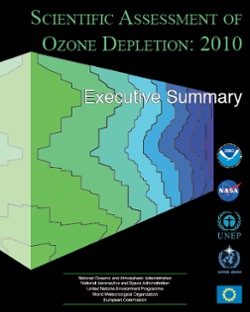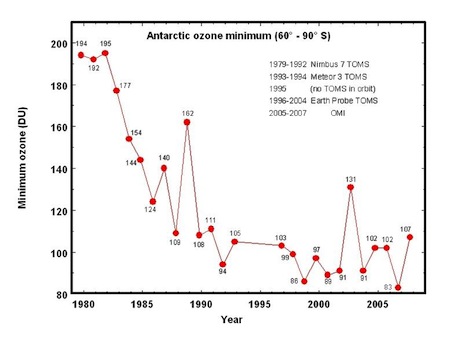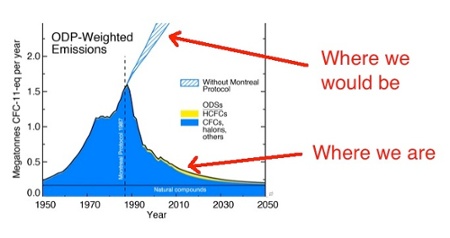The Science Behind the Phase-Out of R-22 Air Conditioner Refrigerant

 This is going to be a short article, mainly just providing a quick summary and some links to the ozone depletion work of the US National Oceanic and Atmospheric Administration (NOAA). In the article I wrote last week about dry-ship R-22 air conditioners and heat pumps, a couple of commenters questioned the science behind ozone depletion. As a physicist, I have respect for legitimate questions being raised. I also have concern about the way science gets abused and turned on its ear by those who want to create confusion that leads to inaction. It’s happened over and over. Just look at the history of tobacco, global warming, and acid rain. Denial and obfuscation are the main tools of those who want to prevent or delay action.
This is going to be a short article, mainly just providing a quick summary and some links to the ozone depletion work of the US National Oceanic and Atmospheric Administration (NOAA). In the article I wrote last week about dry-ship R-22 air conditioners and heat pumps, a couple of commenters questioned the science behind ozone depletion. As a physicist, I have respect for legitimate questions being raised. I also have concern about the way science gets abused and turned on its ear by those who want to create confusion that leads to inaction. It’s happened over and over. Just look at the history of tobacco, global warming, and acid rain. Denial and obfuscation are the main tools of those who want to prevent or delay action.
This is going to be a short article, mainly just providing a quick summary and some links to the ozone depletion work of the US National Oceanic and Atmospheric Administration (NOAA). In the article I wrote last week about dry-ship R-22 air conditioners and heat pumps, a couple of commenters questioned the science behind ozone depletion. As a physicist, I have respect for legitimate questions being raised. I also have concern about the way science gets abused and turned on its ear by those who want to create confusion that leads to inaction. It’s happened over and over. Just look at the history of tobacco, global warming, and acid rain. Denial and obfuscation are the main tools of those who want to prevent or delay action.
It’s no different with ozone depletion. The science says one thing. The deniers say things that sound reasonable on the surface but don’t hold up under the light of scientific scrutiny. Scientists and the NOAA have been on this issue for a long time now, and one of the great things about the Web is that you can easily get access to documents that can dispel the myths. I’ll just make two points here and then let you read the NOAA information if you want to know more.
Ozone depletion is real and caused by us
Ozone depletion occurs in two forms: the general reduction of ozone in the stratosphere and the ozone hole, which appears over the poles each spring. The Antarctic ozone hole is the biggest and has appeared each year without fail since 1980. The ozone levels there have dropped to half what they were in 1980, as the graph below illustrates.

How can the chlorine given off naturally by the oceans explains this? It can’t. Since it’s been stable while the stratospheric ozone has decreased, there’s no correlation. A lot of scientific research has gone into understanding what’s happening here, and the connection between the stuff we’ve been putting into the air and the loss of ozone in the upper atmosphere is rock solid.
The Montreal Protocol is working
In 1987, an international meeting produced the Montreal Protocol for reducing emissions of ozone-depleting substances (ODSs). The first step was to eliminate CFCs and replace them with HCFCs, which were much friendlier to the ozone but still not benign. The next step was to replace HCFCs with even more ozone-friendly substances like HFCs. Here’s a graph showing the effect of the Montreal Protocol on emissions.

If you look at the executive summary of the 2010 ozone depletion report, you’ll see that for the first time, CFC-12—one of the real baddies—has decreased in the troposhere for the first time since they started monitoring ozone-depleting substances. HCFC-22 (the R-22 used in air conditioners), on the other hand, “increased more than 50% faster in 2007-2008 than in 2003-2004.” The big picture looks better, but we still need to close the loophole on dry-ship R-22 air conditioners and heat pumps.
Where to go for more info
Main page for NOAA assessments of ozone depletion
Executive Summary of 2010 NOAA Ozone Depletion Report
Twenty Questions & Answers About the Ozone Layer
The science is solid here. Since Rowland and Molina first discovered ozone depletion and its connection to the stuff we put in the air way back in 1974, scientists have learned more and more about our connection to the environment. Of course, you can choose not to believe it. Just take your seat next to the flat earthers in the corner over there.
This Post Has 13 Comments
Comments are closed.

Allison – THANKS for pumping
Allison – THANKS for pumping into this article some stone cold reality. The current political climate (pun intended) has brought into full relief how difficult it is to counter the very basic instinct of self preservation. When information does not suit or satisfy one’s short term goals, it triggers a basic, dim-witted response in the brain that says “don’t mess with my shit”. Reflexively we must attack… like a baboon on an encroaching competitor. The problem is that this knee-jerk response is akin to dealing with a GFI receptacle tripping – it is almost always related to a bigger problem. Most of us take the easy way out: hit the “reset” button and go about our business.
As arbiters of the single most influential impact on carbon production – players in the built environment – we need to hit the “pause” button before hitting the “reset” button.
I don’t give a rats ass what your political persuasion. 90%+ of the really smart people say we have a problem. If they say we have a problem, then we need to listen. Just as we tune into our local meteorologists for answers when storms come calling. Just as we expect folks to listen to our expertise in building science.
On the flip side, if any deniers or naysayers have a cow that predicts the weather better than the folks we listen to on TV or the Web, or can refute why the insurance industry actuaries are planning for worst-case weather scenarios, I’m all ears.
If you have nothing more to say than regurgitated cable news talking points, you aren’t thinking for yourself, and therefore, there’s no reason why anyone else should listen to you.
AS A CAPITALIST I would never bet against the house. If 90%+ of the gurus say, “Houston, we have a problem” then I would be a compleat idiot to take those odds. Unless of course I was a teenage trick skateboard rider; then I would have no choice but to blindly pursue the SHORT TERM adrenalin rush of ultra-high risk taking and near-certain injury. Yeah… this is the mentality we want making decisions for us. Yikes!
“The conservation of natural resources is the fundamental problem. Unless we solve that problem it will avail us little to solve all others.”
– Theodore Roosevelt, Republican President, Address to the Deep Waterway Convention, October 4, 1907
As many of you know R-22 use
As many of you know R-22 use is rampant. Most of the world is not slated to stop producing R-22 until 2030 in developing countries (like Saudi Arabia).
One downside is that replacements like 410A and 407C produce lower efficiencies at high temperatures. Unless there is serious work done on improving the efficiency of air conditioners and refrigeration at high temperature we will increase the emission of greenhouse gasses generating electricity.
You want “high
You want “high efficiency” in your refrigeration systems, R12 was probably the most efficient and produced the most “cold” for the money of anything we have used since there has been refrigeration.
Just learn how to contain it so it stays in the air conditioner and doesn’t get into the air, and everyone will be happy.
R12 has very high efficiency.
R12 has very high efficiency. R11 used in centrifugal water chillers from 200 – 1000 tons had the highest efficiency of any refrigerant. So in my textile air conditioning days I am probably responsible for indirectly putting about 300,000 lbs of R11 into the atmosphere assuming that none of the refrigerant was reclaimed. We did a good job of containing it but by 1990 almost 80% or the R11 consumption was being used to expand foam insulation and for cleaning circuit boards. Once a manufacturer has a product they will sell it for any use!
Nice piece Allison but as for
Nice piece Allison but as for science & obfuscation lets get serious
Ozone depletion was easy to diagnose & prove the cause
Global Warming caused by humans is nothing but a huge shell game using items like GWP with a 50% error rate on the formulas to start with, falsifying numbers, temperature sensors now located in the middle of cities, etc… http://blog.sls-construction.com/2010/sustainability-green-building-and-you
Tobacco smoke – yes it is bad for you, but for 2nd & 3rd hand being just as dangerous & with an increasing number of illness while the levels of smokers has declined is laughable at best. Maybe they ought to have these peoples houses tested for Radon
Harris W.:
Harris W.: It seems I touched a nerve there. It’s certainly a big, important issue worthy of strong feelings. I love the Teddy Roosevelt quote!
John P.: In my view, it doesn’t do us a whole lot of good to make further improvements in air conditioner efficiency when we’re currently throwing away so much of the efficiency of the systems we already have. I’m referring to the crappy distribution systems we attach our efficient air conditioners to and the the crappy building envelopes we put them in. Those are easy gains. I do agree that we need to keep working on increasing the efficiency of the units themselves, too, though.
Ira: I doubt we’re ever going back to R-12, containment or no.
Don G.: I doubt that my grandfather, as a contractor, put 300,000 lbs of freon into the atmosphere, but I’m sure it was a lot. The good news is that we don’t do that anymore.
Sean: A huge shell game? Really? Of course, you’re free to believe what you want. That doesn’t change the science, which grows stronger every year.
Stay tuned. I’ve avoided discussing global warming up to now, but I’ll be writing about that soon.
Hi Alison,
Hi Alison,
Interesting posts.
There are lots of “Flat Earth” folks in HVAC, you will
Get quite a fight on this one.
For a real challenge, try de-bunking the myth that you can “Calculate” an accurate load on an old house by adding guesses in your computer.
This business is not full of rocket scientists, we prefer not to have our beliefs challenged by facts.
Pj
Allison. We agree that
Allison. We agree that buildings should get better. One advantage of working on an AC is that all that energy goes through one place == the AC. The gains and losses in the building are diffuse. The duct system issue is a slam dunk. Don’t use ducts.
Pj: Well,
Pj: Well, I like a good fight. So far, I’ve been surprised to find that the HVAC community has been pretty silent on this issue, though.
John P.: True! So are you with Bruce Manclark on this and promoting ductless mini-splits for everything?
“A huge shell game?
“A huge shell game? Really? Of course, you’re free to believe what you want. That doesn’t change the science, which grows stronger every year…”
Seriously, I got to ask if you even read the comment (much less the link) with a slightly open mind, much less understood what was said, or did you just see “denier”?
As I said science was right about ozone, and numerous other things like acid rain, gravity, etc… but that does not automatically make all their “theories” correct. This is especially true when many are not being real scientists looking for the facts but rather pushing a social agenda & many get derided for pointing out issues or rocking the boat.
Good luck with your post on GW, though I am sure you might just find out that it isn’t as easy as you may think it is
Sean: Yes,
Sean: Yes, I did read the comment, and as you can tell from the comment I left in your blog post two years ago, I read that, too, both with an open mind. Or at least I tried to, but I guess that’s a bit hard to do when I run into a statement like the following:
Global Warming caused by humans is nothing but a huge shell game using items like GWP with a 50% error rate on the formulas to start with, falsifying numbers, temperature sensors now located in the middle of cities, etc…
That reads like it came straight out of the Frank Luntz playbook, Sean, and sounds like something that someone who doesn’t have an open mind might say. Sure, scientists aren’t as good at getting the message out as those who want to create confusion with the goal of delaying action, and that leads people to write and say things like you wrote above.
But we’re getting ahead of ourselves here. This article is about ozone depletion, which we seem to agree on. Let’s save the global warming debate for my future posts on that topic. And by the way, I’m fully aware of the complexities of that debate. I don’t know why you would jump to the conclusion that I think it’s ‘easy.’
Oh, just one more thing — putting the word ‘theories’ in quotes makes you look anti-science, which I don’t believe you are. A theory, in the scientific hierarchy is actually an idea that’s well established with a lot of data to back it up. Perhaps you meant to use the word ‘hypotheses.’
If you realize on 3 percent
If you realize on 3 percent of all carbon dioxide is put into the atmosphere by humans, I can’t imagine how little impact this would have on the total gasses in the atmosphere.
There is a lot more carbon dioxide put into the atmosphere by humans, with all their activity, and it only amounts to 3 percent of all carbon dioxide in the atmosphere. But we’re the problem? Dead plants put in much more than all human activity in total. Again, compared to that, the amount of R22 in the atmosphere would be negligible, compared to all gasses put into the atmosphere.
JShouts:
JShouts: This article is about ozone depletion, not global warming. The complexities and subtleties of science require clear thinking, and that starts with understanding the problem at hand. If you want to argue about global warming, you’re commenting in the wrong article.